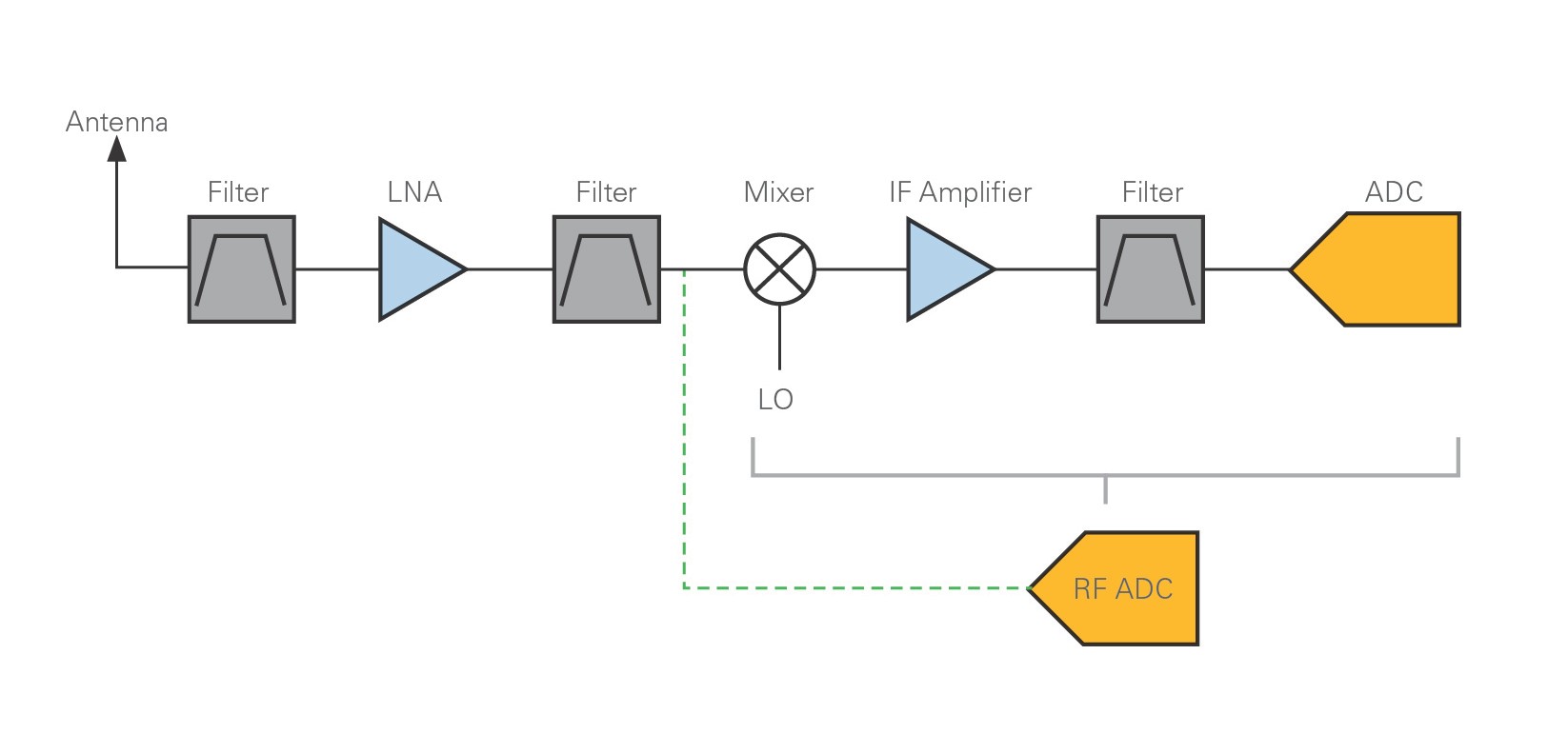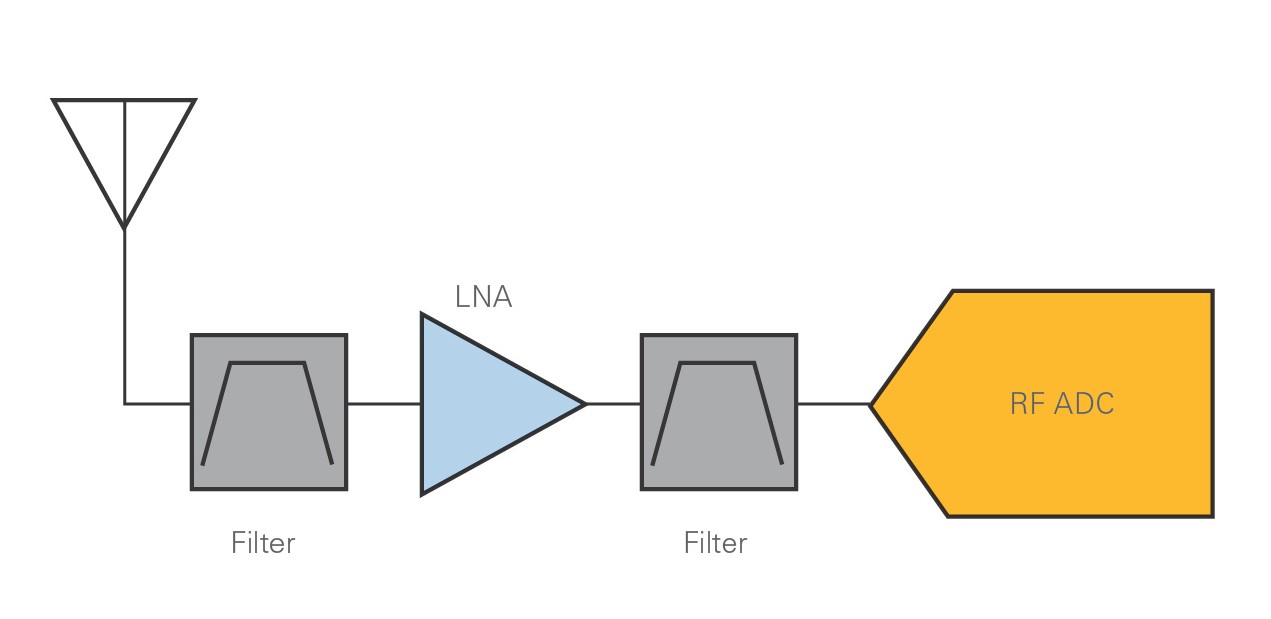Advantages of Direct RF Sampling Architectures
Overview
Converter technology continues to evolve year after year. Analog-to-digital converters (ADCs) and digital-to-analog converters (DACs) from major semiconductor companies sample at rates orders of magnitude faster than their predecessors even ten years ago. For example, in 2005, the world’s fastest ADCs with 12-bit resolution sampled at 250 MS/s; in 2018, 12-bit ADCs can sample 6.4 GS/s. Thanks to these performance advances, you can use converters to directly digitize signals at RF frequencies and achieve sufficient dynamic range for modern communications and radar systems.
Though you need to consider trade-offs when using converters with such high sample rates (primarily dynamic range), this technology allows you to exchange widely used heterodyne RF architectures in favor of direct RF architectures for certain applications. For example, in wide-bandwidth RF applications that require smaller form factors or reduced cost, the simplified front end of direct RF instruments can be a powerful option. In particular, this technology has gained momentum in some aerospace and defense applications like radar and electronic warfare.
Contents
- What is Direct RF Sampling?
- How is Direct Sampling Achieved?
- When Should I Consider Using a Direct RF Sampling Architecture?
- What is NI's Role?
What is Direct RF Sampling?
To understand the direct RF architecture, you need to know how it differs from other RF architectures.
In a heterodyne architecture, after the receiver receives the signal at RF frequencies, it downconverts the signal to a lower intermediate frequency (IF) where it is digitized, filtered, and then demodulated. Figure 1 shows a heterodyne receiver block diagram. As you can see, the instrument has an RF front end that consists of a bandpass filter, low-noise amplifier, mixer, and local oscillator (LO).
Figure 1: This heterodyne receiver block diagram shows an instrument with an RF front end that consists of a bandpass filter, low-noise amplifier, mixer, and local oscillator.
A direct RF sampling receiver architecture, however, consists of just a low-noise amplifier, the appropriate filters, and the ADC. The receiver in Figure 2 does not use mixers and LOs; the ADC digitizes the RF signal directly and sends it to a processor. In this architecture, you can implement many of the analog components of the receiver in digital signal processing (DSP). For example, instead of a mixer, you can use direct digital conversion (DDC) to isolate your target signals. Also, in most cases, you can replace much of the analog filtering with digital filtering except for the anti-aliasing or reconstruction filters.
Because analog frequency conversion is not required, the overall hardware design of a direct RF sampling receiver is much simpler, thus allowing for smaller form factors and lower design cost.
Figure 2: A direct RF sampling receiver architecture can consist of just a low-noise amplifier, the appropriate filters, and the ADC.
How is Direct Sampling Achieved?
Prior to the advancement of converter technologies in recent years, direct sampling architectures weren’t practical because of the limitations in converter sample rates and resolution. Semiconductor companies have been able to expand resolution at higher sampling frequencies using new techniques to reduce noise within the converter. With the availability of much higher-speed converters featuring increased resolution, you can directly convert RF input signals up to several gigahertz.
This conversion rate enables digitization with very wide instantaneous bandwidth at the L- and S-bands. As converters continue to evolve, direct RF sampling at other bands (such as C- and X-bands) will likely become viable as well.
When Should I Consider Using a Direct RF Sampling Architecture?
The main benefits of direct RF sampling are a simpler RF signal chain, decreased cost per channel, and less channel density. With fewer analog components, instruments featuring a direct RF architecture are typically smaller and more power efficient. If you are building high-channel-count systems, direct RF sampling can decrease the footprint and cost of your systems. This can be especially important when building systems such as fully active phased-array radars, which form beams by phase shifting the signals emitted from up to hundreds or even thousands of antennas. With this many RF signal generators and analyzers in the same system, size and cost per channel become an important factor.
In addition to the size, weight, and power (SWaP) reduction, the simplified architecture removes potential sources of noise, images, and other errors, such as LO leakage and quadrature impairments, within the RF instrument itself.
Finally, direct RF sampling architectures can also simplify synchronization. For example, to achieve phase coherence for RF systems, you must synchronize the internal clocking of the RF instruments as well as the LOs. In direct sampling, which requires no LOs, you can focus only on the clock synchronization of the devices. Again, for phased-array radar applications that have several RF receivers that must be phase coherent, this can be an appealing option for simplifying your design.
What is NI's Role?
NI provides several RF instruments with many RF architecture types; however, the FlexRIO IF transceiver is the first NI instrument to take advantage of direct RF sampling. As the capability of high-speed converters expands, NI will continue to work closely with vendors to rapidly provide these emerging technologies to its customers.


